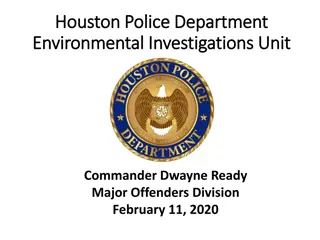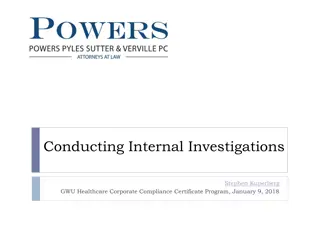Understanding Investigations in Science
Investigating in science involves various approaches beyond fair tests, such as pattern-seeking, exploring, and modeling. Not all scientists rely on fair tests, as observational methods are also commonly used. The scientific method consists of steps like stating the aim, observing, forming hypotheses, and drawing conclusions. Fair testing investigations focus on changing one variable while keeping others constant to observe the effect on another variable. Different types of investigations include modeling, pattern-seeking, exploring, and developing systems. Pattern-seeking investigations aim to find relationships between variables to suggest causal links without direct manipulation.
Download Presentation

Please find below an Image/Link to download the presentation.
The content on the website is provided AS IS for your information and personal use only. It may not be sold, licensed, or shared on other websites without obtaining consent from the author. Download presentation by click this link. If you encounter any issues during the download, it is possible that the publisher has removed the file from their server.
E N D
Presentation Transcript
Investigating is more than just fair tests Mike Stone Nov 2023
NZC Science Aim Investigating in science: Carry out science investigations using a variety of approaches: classifying and identifying, pattern seeking, exploring, investigating models, fair testing, making things or developing systems. 2
Not all scientists do fair tests Geologist s & astronomer s investigations are based on looking for patterns in extensive observations Other scientists such as Charles Darwin & Jane Goodall routinely used observational (qualitative) approaches 4
There is no such thing as the scientific method 1. State the aim 2. Observe & research 3. Form an hypothesis 4. Devise a method 5. Collect data 6. Analyse data 7. Draw conclusions 5
Fair testing investigations An investigation where only one variable is changed while all others are kept the same (controlled), observing or measuring the effect on another variable E.g. Measuring strength of flax fibres Other examples?
Other types of investigations Modelling Pattern-seeking investigations Exploring Classifying and identifying Making things or developing systems
Pattern-Seeking Investigations Find relationships between variables that can t be controlled or manipulated to suggest causal links E.g. field work in geology, astronomy, ecology meteorology. E.g. using data sets in any science E.g. Sampling activities eg zonation on shore or salinity levels upstream from estuary; Vitamin C or pH in fruit/veges; apparent movement of Mars in the night sky; movement of a fault-line across sedimentary beds; link between moon phase & fishing success. Looking for patterns in data: average temperature at different latitudes; no. of C atoms vs melting point; 9
Modelling investigations A model is a visual representation of a science idea - digital, diagrammatic, physical, or imaginary E.g. Current (munchkins, water flow); atom; states of matter (beads on speaker); bell-jar lung model; weather map; planet distances Students can Make a model Discuss the uses and limitations of the model Explore the effect of changing a part of the model this is the investigation L1 modelling investigations must collect data / observations observing effect of a disinfectant on an agar plate full of bacteria collecting data from a PhET investigation comparing the temperature of a beaker of hot water in an insulated cardboard house with an uninsulated one testing different model waka in water hull shape, sail shape 10
Exploring investigations Record careful observations of events or objects May look for changes in 1 variable over time Eg change in moon shape over a month; life history of a monarch butterfly, Often includes visual image a labelled drawing or photograph eg microscopic observations For example Observing the outside of a glass of water water cooling Comparing adult and juvenile forms of a native plant Observing a single-celled organism like Euglena feeding Observe the effect of thick/thin lenses & mirrors on light rays Observe precipitation reactions 11
Classifying & identifying investigations Classify = arrange into groups Identify = find the group a thing belongs to, naming it. Students may need to explore/observe before classifying Use a key Refine a key Design a key? This approach can be used in the study of leaves, rocks, invertebrates, metals, molecules E.g. Identify type of molecule modelled by molymod Identify the acids and bases in a set of unknowns Develop a way of identifying common whelks Classify macroinvertebrates seen in a stream 12
Investigate by making things or developing systems Design an artefact or system to meet a need Eg make a lizard-friendly habitat BP Technology Challenges make flax baskets for a hangi design a system to show a series of energy changes
Multiple approaches in 1 activity Forest study Key of plants native vs non native Transect lines pattern-seeking investigation Comparison of two stream sites Key to identify organisms Explore - draw organisms with labels Pattern-seeking investigation Geological study Explore & observe rocks present Classify rocks Look for a pattern in strata or landforms 14
Lets try some Science Learning Hub Education Perfect Investigations ARBs: https://arbs.nzcer.org.nz Science online tki https://scienceonline.tki.org.nz PhET simulations UK s STEM Learning 15
Do we recognise them? From what direction does the wind tend to come at my school? How can I test an explanation of how pollen travels from flower to flower? How can I find the best method to separate Raro crystals from sand and shells? How can I find the name of common spiders in my home? How does the appearance and location of comet change over several days? Which native plant extract has the strongest effect on E coli bacteria? Classifying & identifying Exploring Fair testing Modelling Making things & developing systems Pattern seeking
Education Perfect Investigations https://www.educationperfect.com join up for free Science Alive M tauranga Te Taiao Investigations Bioplastic: Eco-friendly with Hangarua (make a bioplastic, adapt recipe) Growing from a seed: Te K kano (best soil for growing beans) Living between the tides: Te Ara o Hinekirikiri (observe where different organisms grow on the shore) Pests or pals: Tiro ma riha r waho (identify and count insects) Powered by the sun: Tamanuiter (make a solar oven) Strata: Layers of history in Papat nuku (observe strata locally) Student resources and teacher guide for each
https://www.stem.org. uk/elibrary/resource/28 910 UK PLD, resources Free to join Lesson plans, handouts 20























